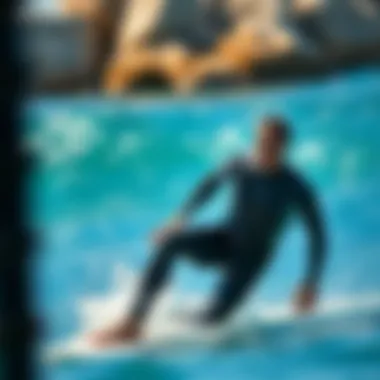Top Men's Wetsuits of 2021: A Detailed Review


Intro
When it comes to water sports, especially kiteboarding, having the right gear can make all the difference. The foundation of a great experience on the water often lies within the wetsuit you choose. In 2021, the market presented a multitude of men’s wetsuits, each designed with specific features that cater to various needs in varying water conditions. Whether you are a beginner just taking your first dip or an experienced kiteboarder carving out your path on the waves, this guide will illuminate your path to find the best wetsuit for your adventures.
Wetsuits not only keep you warm but also play an essential role in enhancing your performance. The materials used, the fit, and the insulation properties can directly impact your comfort and agility in the water. This comprehensive guide will dissect these aspects, examining a selection of the top models on the market and their suitability for different water activities. Our goal is to provide clarity, ensuring you make an informed decision that aligns with your specific preferences and water sport aspirations.
Gear and Equipment
Understanding the right gear and equipment is paramount for any kiteboarder. Selecting a wetsuit is just one piece of the puzzle, but it plays a pivotal role in your overall performance. Here, we’ll delve into the essentials that every kiteboarder should consider.
Essential Kiteboarding Gear for Beginners
For those just starting out, having the basics will set your journey alight. Here’s a rundown of must-have gear:
- Wetsuit: A good fit is key. Look for a wetsuit that provides insulation yet allows for free movement. Neoprene thickness varies, so consider what water temperatures you'll encounter.
- Kite: Choose a size that matches your weight and wind conditions. Beginners often prefer larger kites for easier handling.
- Board: A larger, more stable board will help you get accustomed to riding and maneuvering.
- Harness: A comfortable harness will relieve pressure during those long rides, so make sure it fits snugly without being too tight.
- Safety Leash: This is crucial for preventing the kite from drifting away if you fall.
Advanced Equipment for Experienced Riders
As you progress and refine your techniques, you might find a need for specialized equipment. Consider these advanced options:
- High-performance Wetsuits: Look for suits with top-notch thermal technology and flexible materials. Suits from brands like O'Neill or Rip Curl often offer durability and versatility.
- Slick Kite Designs: Advanced kites come with features like better responsiveness and enhanced control, allowing for tricks and jumps.
- Tailored Boards: Your riding style influences your choice of board. A surfboard style might suit wave riders, whereas a twin tip may be better for flat water.
"Investing in quality gear can elevate your kiteboarding experience, making it safer and more enjoyable."
Techniques and Tips
Mastering kiteboarding involves not just the right gear, but also techniques and safety practices that should never be overlooked.
Safety Practices for Kiteboarding
Safety should always top your priority list. Here are some essential tips:
- Check Weather Conditions: Wind strength and direction can drastically affect your riding experience. Always heed local forecasts.
- Buddy System: Never head out alone, especially as a beginner. Having someone with you can provide an extra layer of safety.
- Know Your Limits: If you’re feeling fatigued or overwhelmed, it’s best to call it a day. Personal safety comes first.
Training Techniques to Improve Your Skills
Improvement in kiteboarding is largely about practice and technique. Here are some training techniques to consider:
- Video Analysis: Filming your sessions can reveal areas for improvement.
- Control Drills: Spend time practicing your loopy turns and jumps on the sand before hitting the waves.
- Join a Local Club or Community: Engaging with other kiteboarders can provide support, tips, and possibly even mentorship.
With a strong understanding of gear, safety, and techniques, you’ll be better equipped to navigate the thrilling waters of kiteboarding. In the subsequent sections, we will break down the top men’s wetsuits available in 2021, analyzing their materials, insulation properties, and specific applications to find the best fit for your kiteboarding adventures.
Foreword to Wetsuits
Wetsuits are much more than just a fashionable beach accessory; they are essential gear for anyone engaging in water sports. They provide vital insulation and protection, enabling enthusiasts to fully enjoy activities like kiteboarding, surfing, or diving across a range of temperatures and conditions. In this article, we’ll dive into understanding how wetsuits work, their important role in water sports, and the advancements that have shaped modern wetsuit technology.
Understanding the Purpose of Wetsuits
The primary purpose of a wetsuit is to offer thermal insulation while allowing a good degree of flexibility. When someone submerges in cool water, body heat is lost much quicker than on land, which can lead to discomfort or even hypothermia in extreme situations. Wetsuits are typically made from neoprene, a flexible material that traps a thin layer of water between the suit and skin. The heat generated by the body warms this trapped water, providing a barrier against the cold.
In essence, wetsuits strike a balance between comfort and performance, allowing the wearer to maintain body heat while still moving freely. For kiteboarders, the need for such flexibility is critical—not just for maneuverability on the board, but also for paddling or swimming back to shore when necessary.
The Evolution of Wetsuit Technology


Wetsuit technology has come a long way since its inception. Earlier models were bulky and heavy, limiting movement and enjoyment in the water. However, through the years, advancements have transformed these suits into lightweight wonders that maintain warmth without sacrificing agility.
Modern wetsuits come with features like anti-chafing seams, moisture-wicking linings, and streamlined designs that improve aerodynamics. The rise of factories employing cutting-edge methods has also led to the production of suits that conform to different body shapes, enhancing fit and comfort. What’s more, many brands are now focusing on eco-friendly materials and sustainable practices, making wetsuits that are not only better for the wearer but also for the environment.
"A wetsuit's technology can make the difference between an exhilarating experience and a cold, miserable one."
All these advancements feed into the overall aim—enhancing both performance and comfort in various water conditions. As we continue to explore the best men’s wetsuits from 2021, understanding these features can help you discern what’s essential for your aquatic pursuits.
Criteria for Selecting a Wetsuit
Selecting the right wetsuit is no small feat; it’s about finding that perfect balance between performance and comfort. Given the vast array of options available on the market today, knowing what to prioritize can significantly enhance your experience, especially in dynamic sports like kiteboarding or surfing. The right fit can mean the difference between a great day out in the water and one spent shivering on the shore.
Material Variations and Their Benefits
When it comes to wetsuits, the material is paramount. Most wetsuits are crafted from neoprene, but not all neoprene is created equal. You'll find variations like limestone-based neoprene, which is more eco-friendly and offers superior insulation. Other materials sometimes used are spandex, which adds flexibility, and lining materials that can improve comfort.
Making sense of these options requires an understanding of how each material performs under different conditions. For instance, high-stretch neoprene provides excellent freedom of movement, which is crucial for activities that require agility. Conversely, thicker materials are better suited for colder waters as they offer more insulation.
Insulation and Thickness Considerations
The insulation a wetsuit provides is fundamentally linked to its thickness. Wetsuits typically range from 2mm to 6mm in thickness, with choice dependent on the water temperature. A 3/2mm suit is generally ideal for cooler climates, giving warmth without compromising flexibility. Meanwhile, 5/4mm suits are better for frigid waters, though they may feel bulkier.
Consider also how insulation affects buoyancy. Thicker materials can offer added buoyancy, helping you to float easier. But if you’re borderlining on the warmer side, opting for a thinner model can keep you from overheating while still shielding you from wind chill.
Fit and Comfort Aspects
The fit of a wetsuit is where we really get into the nitty-gritty. A snug fit is crucial; too loose, and you'll feel like a fish out of water, with cold taking advantage of any gaps. If it's overly tight, you might find your range of motion severely restricted, which can be a big problem when you’re out hitting the waves.
To achieve the perfect fit, consider looking for suits with adjustable features, such as zippers or straps. Also, pay attention to styles such as back zip, front zip, or even the ever-popular chest zip, which often provide a better seal against water. Here’s a tip: always try before you buy, if possible, to just make sure it hugs you rightly without feeling like a straightjacket.
Ease of Entry and Exit
Finally, the ease of getting in and out of your wetsuit can be a make-or-break factor. When you’re in a rush or the weather turns chilly, fidgeting with complicated zippers or straps can be frustrating. Look for features like quick-dry linings and easy-entry designs that don’t compromise on performance. Chest zips, for example, often allow a larger entry point than back zips and can be simpler to manage.
It’s also worth mentioning that many modern models now offer innovative zipper systems that enhance both ease of use and water sealing. If you’re planning spends long hours in and out of your suit, the right choice in this category really can save you several headaches.
"Finding the right wetsuit combines practicality with a touch of personal preference, shaping how you interact with water. Don't just consider the specs, think about how you leverage that technology for your specific sport!"
Top Men's Wetsuits of
Selecting the right wetsuit can undeniably make or break your time in the water. In 2021, the market has seen an expansion of options suited not only for experienced athletes but also for newcomers to water sports. This section delves into various types of men's wetsuits, addressing features, pricing, and specialized design considerations that make each model stand out. From high-performance choices for the pros to budget-friendly options, understanding these will assist you in enjoying kiteboarding or other aquatic adventures without hindrance.
High-Performance Models
These wetsuits cater to those seeking maximum performance, typically used in competitive scenarios or serious water activities where every second counts.
Features and Specifications
High-performance wetsuits are often crafted with cutting-edge materials aimed at providing unparalleled flexibility and warmth. These models commonly utilize neoprene with a high stretch factor, allowing for better movement. One notable characteristic is the incorporation of super-thin panels, particularly around the joints, making it easier to paddle or maneuver effortlessly.
Advanced technology, such as welded seams instead of traditional stitching, adds durability and reduces water entry. However, while these features increase performance, they might come with higher price tags that could dent the wallet. Still, for enthusiasts, the benefits of improved maneuverability can outweigh the cost.
Price Range Analysis


When it comes to high-performance wetsuits, pricing can be quite varied. Expect options that range from $300 to over $700. While it sounds steep, these wetsuits often incorporate the latest materials, optimizing performance in challenging conditions. Their uniqueness lies not just in the brand but also in innovation that allows for minimal drag and anticipated insulation.
The trade-off to consider is that while some brands boast higher price points due to advanced technology, consumers must verify their claims with actual performance metrics or extensive user feedback. If you're serious about performance, investing in a reputable model often pays dividends in the long run.
Budget-Friendly Options
If shelling out over a hundred dollars isn’t feasible, don’t fret. There are plenty of budget-friendly wetsuits that can offer good value without compromising necessary features.
Value for Money Assessment
For those looking to maximize their dollar, budget options can still deliver essential insulation and flexibility. These models often use a thicker neoprene which, while it may offer less stretch, is enough to keep casual users warm in moderate temperatures. Keeping in mind that the cost ranges from about $100 to $250, it is crucial to assess what features you're willing to compromise on.
One distinctive trait of budget wetsuits lies in their usability. Although they may not be as performance-oriented, they often possess simple entry methods, making them perfect for beginners.
User Feedback Overview
Reading through user feedback provides valuable insights into the practical performance of these wetsuits. Many entry-level models receive praise for comfort and ease of use but may also carry critiques about durability.
Reviews commonly highlight aspects such as fitting or difficulty in taking off after a prolonged period in water. Ultimately, while these wetsuits might lack advanced materials, their practicality for beginners makes them a solid choice.
Wetsuits Tailored for Warm Water Conditions
Not all wetsuits are designed equal; warm water suits prioritize breathability and lightweight designs.
Design Features
Wetsuits meant for warm climates usually feature thinner materials, often between 1mm to 2mm thick. This design ensures adequate insulation without inducing overheating during action sequences in the water. Unique, breathable panels also help expel excess heat while maintaining flexibility.
However, lighter does not always mean weaker; many warm-water designs integrate durable stitching techniques aimed at long-lasting wear, which can be vital for those who engage in more rigorous water activities.
Recommended Use Cases
These suits are particularly suited for tropical waters or during summer months when the temperature is comfortably warm. Scuba divers, surfers, and kiteboarders often reach for these, as they facilitate movement without the encumbering weight of thicker suits. Users often report a more enjoyable experience when wearing lighter garments, focusing on the thrill of the activity rather than adjusting an overheated outfit.
Cold Water Wetsuits
On the flip side, cold water wetsuits are designed to insulate against frigid temperatures.
Insulation Innovations
Innovations in insulation play a massive role in cold water wetsuits, with materials designed to trap body heat while allowing for mobility. A favored choice is the use of plush-lined neoprene, which not only retains warmth but also feels comfortable against the skin.
Additionally, the latest designs often feature thermal lining that maximizes heat retention without adding bulk. Although these suits may come at a higher price point—from $200 to $600—many find them indispensable when battling colder surf.
Comparative Performance Metrics
When evaluating cold water wetsuits, comparisons often arise surrounding flexibility versus insulation. Users generally expect their chosen wetsuit to keep them warm without limiting movement, leading to a desire for models that balance both. Detailed reviews and feedback commonly indicate which products meet these performance metrics effectively, guiding consumers towards well-regarded options.
Versatile Wetsuit Options
The market also showcases wetsuits that promise to serve multiple purposes, valuable for those who dabble in various water sports.
Multisport Usability


Wetsuits designed for multisport usability generally offer a blend of characteristics derived from warm and cold water models. They often feature adjustable elements such as detachable hoods or varied thickness that allow individuals to adapt to changing conditions. This versatility makes these suits favorable among kiteboarders who might encounter fluctuating temperatures in a single day.
A noted strength of these models is their cost-effectiveness; investing in one well-rounded suit can often save money in the long run compared to buying separate suits for each sport.
Durability Factors
Durability is paramount for surfers and kiteboarders who subject their wetsuits to rigorous daily use. Versatile wetsuits generally incorporate reinforced seams that withstand repeated stress while maintaining thermal properties. While these models are tightly constructed for resilience, they might compromise on some specialized performance traits favored in high-sport wetsuits.
Both advantages and disadvantages exist within this category, often requiring the user to evaluate their priorities and frequency of use before making a purchase decision.
Caring for Your Wetsuit
Taking care of your wetsuit is not just a matter of keeping it clean; it’s about preserving the integrity of the material and extending the life of the suit you rely on for your water adventures. A well-maintained wetsuit can enhance performance, keep you warm, and save you money in the long run. Let’s dive into the details of how to properly care for your wetsuit, which is especially crucial for kiteboarders and other water sports enthusiasts who wear their suits frequently.
Proper Cleaning Techniques
Cleaning your wetsuit is an essential practice that shouldn’t be overlooked. After every session, rinse your wetsuit thoroughly with fresh water to remove salt, sand, and chlorine. Saltwater can be particularly harsh, leading to material degradation over time. Here’s a simple method to ensure your wetsuit gets the care it needs:
- Rinse the inside and outside of the wetsuit with cold water.
- Use a mild detergent, specifically designed for wetsuits, to wash in a tub. No high-powered cleaners here, as they can do more harm than good.
- Gently scrub any particular stains or areas of concern with a soft cloth or sponge, being cautious around seams.
- Rinse again until all detergent is washed away.
Allow your wetsuit to air dry by hanging it inside out on a wide hanger, avoiding direct sunlight. Sun exposure can cause the fabric to fade and can weaken the material; thus, a shaded area is ideal.
"Proper cleaning goes by the motto of 'treat your gear right, and it will treat you right.'"
Storage Recommendations
Once you have cleaned your wetsuit, storing it correctly is just as crucial. Unroll any temptation to fold it and stuff it into a tight space. Instead, consider these tips:
- Hang Your Wetsuit: Use a wide hanger to preserve the fit. Hanging the wetsuit helps maintain its form and avoids creases that can weaken the fabric.
- Avoid Tight Spaces: Store it in a cool, dry place. Avoid placing it in a damp or warm area which could foster mold or mildew.
- Check for Dampness: Make sure your wetsuit is completely dry before storage. Storing a damp wetsuit can be a recipe for disaster, resulting in odors and deterioration.
Putting these practices into play not only keeps your wetsuit looking sharp but can also enhance your performance on the water by ensuring the suit remains functional.
Ultimately, taking the time to care for your wetsuit can significantly impact your experience and longevity of the gear you depend on. Your wetsuit deserves the same level of respect you give to your adventures.
The End
Wrapping up this extensive exploration of men's wetsuits, it's important to highlight why the selection of the right wetsuit cannot be underestimated. Choosing a wetsuit is not just about comfort or style; it bears profound implications for performance, safety, and even enjoyment of water sports. With the myriad of options available in 2021, understanding the subtle intricacies of materials, insulation, fit, and purpose can make all the difference.
The key findings from our guide emphasize the necessity to assess specific criteria like material properties—whether you opt for neoprene or eco-friendly alternatives—and the varying thicknesses that suit your preferred water temperature. Also, the fit of a wetsuit is a make-or-break factor; a poorly fitting suit can lead to chafing and ultimately detract from your experience on the water.
Each category of wetsuits we reviewed, from high-performance to budget-friendly options, presents unique features that cater to different user preferences and activities. Whether you're kiteboarding in tropical waters or surfing frigid waves, there's a wetsuit out there designed with your needs in mind.
"A wetsuit is more than gear; it's your second skin in the water, determining not only your comfort but also how well you connect with the elements."
Summarizing Key Findings
From our in-depth review, it's clear that different wetsuits cater to vastly different needs and preferences:
- Materials: Neoprene remains a popular choice, but alternatives are gaining traction for their sustainability.
- Thickness and Insulation: A thicker suit is more suitable for colder climates, while thinner options are best for warmer waters, ensuring comfort and mobility.
- Fit: Prioritizing fit can enhance performance, as too loose a suit can lead to loss of warmth and buoyancy, while too tight a suit restricts movement.
- Ease of Use: Features like zippers, entry systems, and flexibility play crucial roles in the overall experience and efficiency of wearing a wetsuit.
Final Thoughts on Wetsuit Selection
As you set out to choose your wetsuit, remember that it's not just about picking what's trendy or recommended; it’s about what aligns with your specific activities and conditions.
Consider factors such as:
- Water Conditions: What temps will you be facing? Make sure your wetsuit is thick enough for your activities.
- Activity Type: Are you kiteboarding, surfing, or diving? Each sport has unique requirements.
- Budget: While it’s tempting to buy a cheap model, investing in quality can result in better longevity and performance.
Besides materials and fit, also think about the brand support and warranty features offered, as these can save you hassle down the road. In every wave, every swell, wear your wetsuit with pride, knowing you made an informed choice that amplifies your water adventures.



